Preserving Your Valuable Slides: Why Proper Storage Matters
Slide storage is a critical concern for anyone with photographic slides, microscope specimens, or film negatives that need protection and organization. Here's what you need to know:
| Slide Type | Recommended Storage | Capacity | Preservation Materials |
|---|---|---|---|
| 35mm Photographic | Archival boxes or polypropylene pages | 200-480 per box | Acid-free, PAT-passed |
| Microscope | Cabinets or plastic boxes | Up to 5,000 | Polystyrene with numbered slots |
| Glass-mounted | Foam-lined boxes | 80 per standard box | Acid-free with dividers |
Proper slide storage isn't just about organization—it's about preservation. Whether you're protecting family memories captured on 35mm transparencies or valuable laboratory specimens on glass slides, the right storage solution prevents damage from light exposure, dust contamination, humidity fluctuations, and physical handling.
The stakes are high: improperly stored slides can suffer from color fading, emulsion sticking, mold growth, and physical damage. With standard 35mm slide boxes holding up to 200 cardboard-mounted slides and laboratory cabinets accommodating thousands of microscope slides, selecting the right solution for your collection size is essential.
Materials matter tremendously. Archival-quality slide storage products are made from acid-free, lignin-free materials that pass the Photographic Activity Test (PAT ISO 14523), ensuring they won't degrade or harm your slides over time.
I'm Mortuary Cooler, a national-level supplier specializing in preservation equipment including archival slide storage solutions for laboratories and collections. My experience spans decades helping institutions protect their valuable slide specimens with proper storage environments and archival-grade containers.
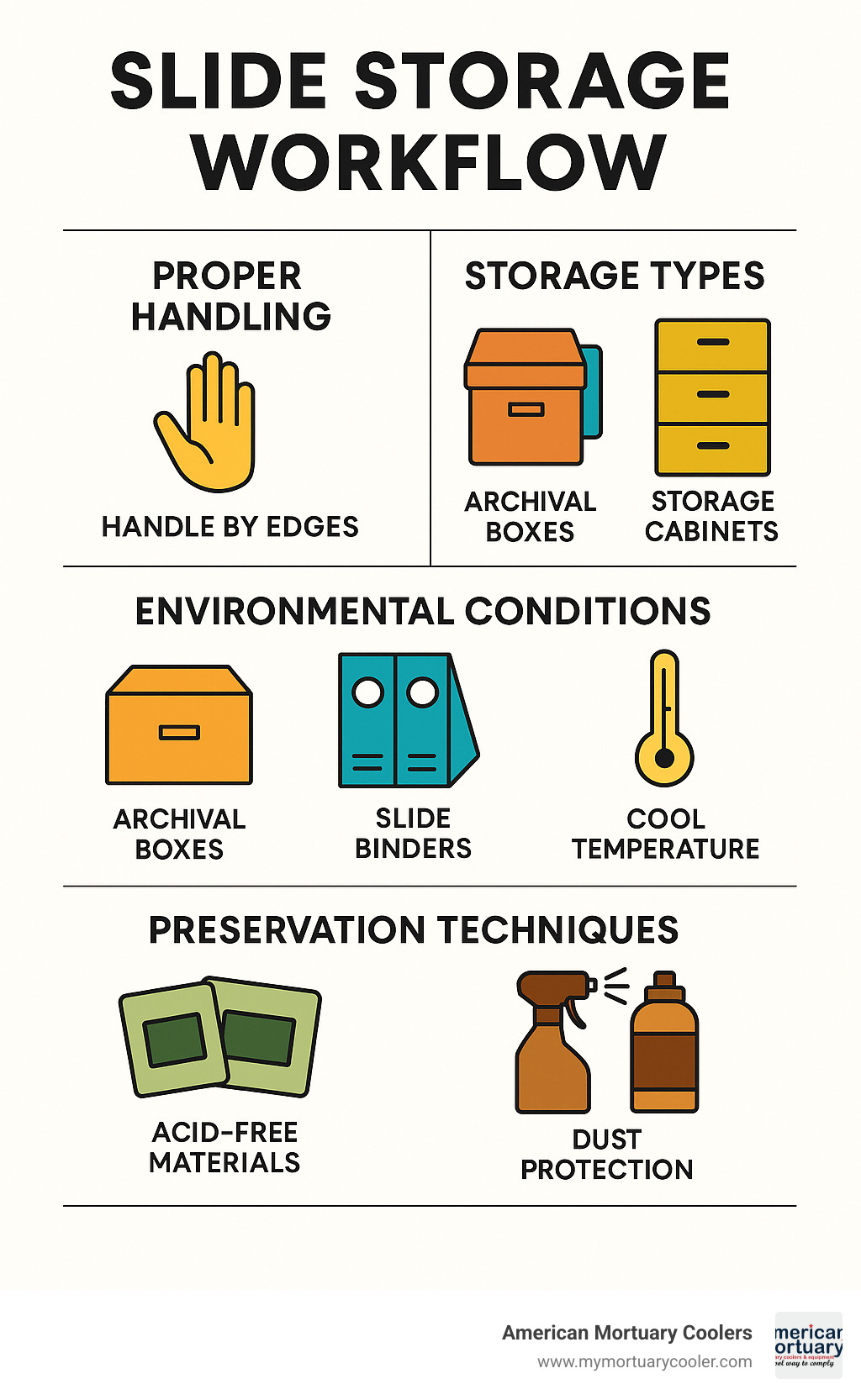
Understanding Slide Types & Their Storage Needs
Let's talk about slides - those tiny windows into preserved moments and specimens. Whether you're a photographer with boxes of family memories, a scientist with irreplaceable specimens, or somewhere in between, knowing what you're working with is the first step to protecting it properly.
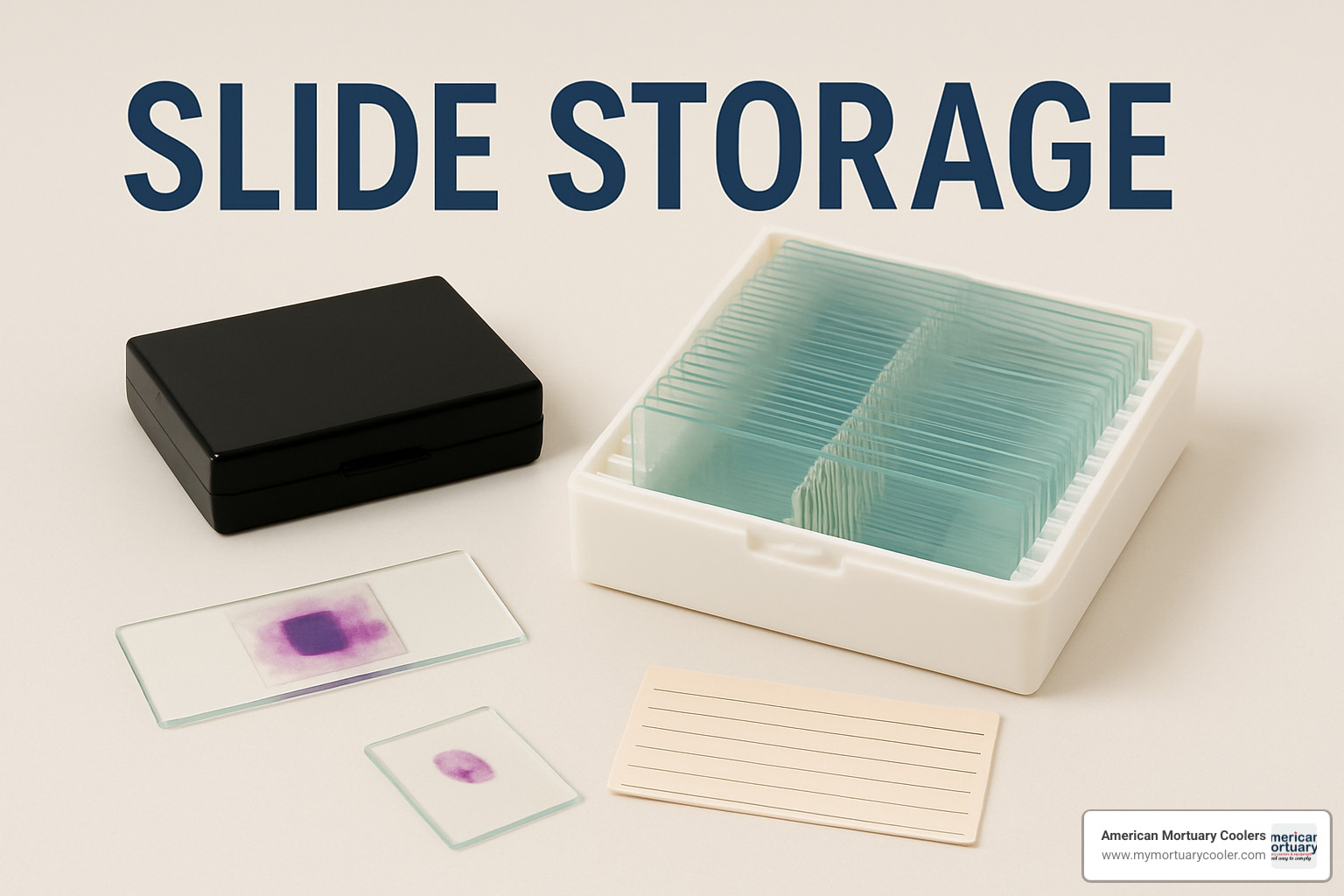
Photographic Slides vs. Negatives
Remember those vibrant little windows to the past? 35mm slides were once how we captured our most precious memories when we wanted truly spectacular color reproduction. Those 2×2 inch cardboard or plastic mounts protected delicate film that could transport us back in time when projected on a screen.
Not all slides are created equal, though. If you're handling a collection of vintage images, you might notice differences. Kodachrome slides tend to hold their colors remarkably well over decades, while Ektachrome slides might show more noticeable color shifts. Both need protection from their worst enemies: light, heat, and humidity.
"Even the smallest details in your laboratory can make the biggest difference, all the way down to your slide storage, whether unused or already prepped," as preservation experts often remind us.
Unlike negatives (which typically live in sleeves or envelopes), mounted slides need storage that prevents the film surfaces from touching anything. Many photographers love clear polypropylene pages that let them see their slides without handling them, while serious archivists might prefer light-blocking acid-free envelopes for their most precious treasures.
Microscope & Histology Slides
If you've spent time in a lab, you know these well - those standard 1×3 inch (25×75mm) glass rectangles that hold the tiniest wonders of biology and medicine. These slides are particularly challenging to store because they're both fragile and often irreplaceable. That tissue section from a rare specimen or that perfectly stained cell structure can't simply be recreated if damaged.
Glass-on-glass contact is the enemy here. Good slide storage for these delicate items incorporates clever design features like raised points or grooved slots to keep the glass surfaces from touching and scratching each other.
For busy histology labs where slides are constantly being pulled for comparison or teaching, smooth-gliding cabinets with ball-bearing suspension drawers are worth their weight in gold. Nothing's more frustrating than a sticky drawer when you're trying to locate that one critical slide among thousands!
Large & Specialty Slides
Some slides break all the rules when it comes to size and format, requiring creative slide storage solutions:
Those beautiful lantern slides (3¼×4 inches) from the early 20th century need sturdy boxes with reinforced dividers to protect their glass surfaces and often hand-colored images.
Super Mega slides used in pathology for larger tissue sections require specialized systems like OmniStor cabinets, which can house around 1,800 unmounted slides safely.
If you work with stereo slides (those wider 2×4-inch mounts), you'll need storage pages specifically designed for their larger format, typically fitting ten per page.
And in many pathology labs, cassette blocks need to be stored alongside their corresponding slides, making integrated storage systems that accommodate both particularly valuable.
For those lucky enough to have diverse collections (or unlucky, depending on how you view the storage challenge!), modular systems that can adapt to multiple formats offer the most flexibility. The good news? When properly stored in high-quality archival containers and kept in stable environmental conditions, your slides can potentially last for centuries, preserving those precious moments or specimens for generations to come.
Why Proper Slide Storage Matters: Risks & Preservation Principles
Let's talk about why good slide storage really matters. Think of your slides like tiny time capsules - whether they hold precious family memories or irreplaceable scientific specimens, they deserve protection that stands the test of time.
Consequences of Improper Storage
When slides aren't stored properly, they face several serious threats that can permanently damage or destroy them:
Light is perhaps the most sneaky culprit. Those beautiful Kodachrome and Ektachrome slides that captured your family vacation in vivid color? Exposure to everyday light - especially sunlight - will slowly but surely drain those vibrant colors away. And once those colors fade, they're gone forever. Ektachrome slides are particularly vulnerable to this invisible enemy.
Dust might seem harmless, but those tiny particles are surprisingly destructive. They don't just make your images look cloudy - when you handle dusty slides, you risk scratching the delicate surfaces as those particles drag across the emulsion or specimen.
Humidity is another major concern. I once heard from a lab technician in Atlanta who shared this heartbreaking story: "We lost nearly 200 irreplaceable pathology slides when they were stored in a basement cabinet during a flooding incident. The cardboard boxes disintegrated, and the slides developed extensive mold growth. Proper cabinets and environmental control would have prevented this disaster."
High humidity (above 60% RH) creates the perfect environment for mold, which can completely destroy slides in just a few months. Too little humidity isn't good either - it can cause the emulsion to crack and flake off.
Physical damage happens more easily than you might think. Improper handling leads to fingerprints, scratches, and breakage. Glass-mounted slides are especially vulnerable - one dropped box can shatter months or years of work.
And let's not forget about emulsion sticking - when slides press against each other in humid conditions, they can literally fuse together, making separation impossible without destroying the image.
Archival Material Standards
Not all storage materials are created equal. When we talk about archival-quality slide storage, we're looking for specific standards that ensure long-term preservation:
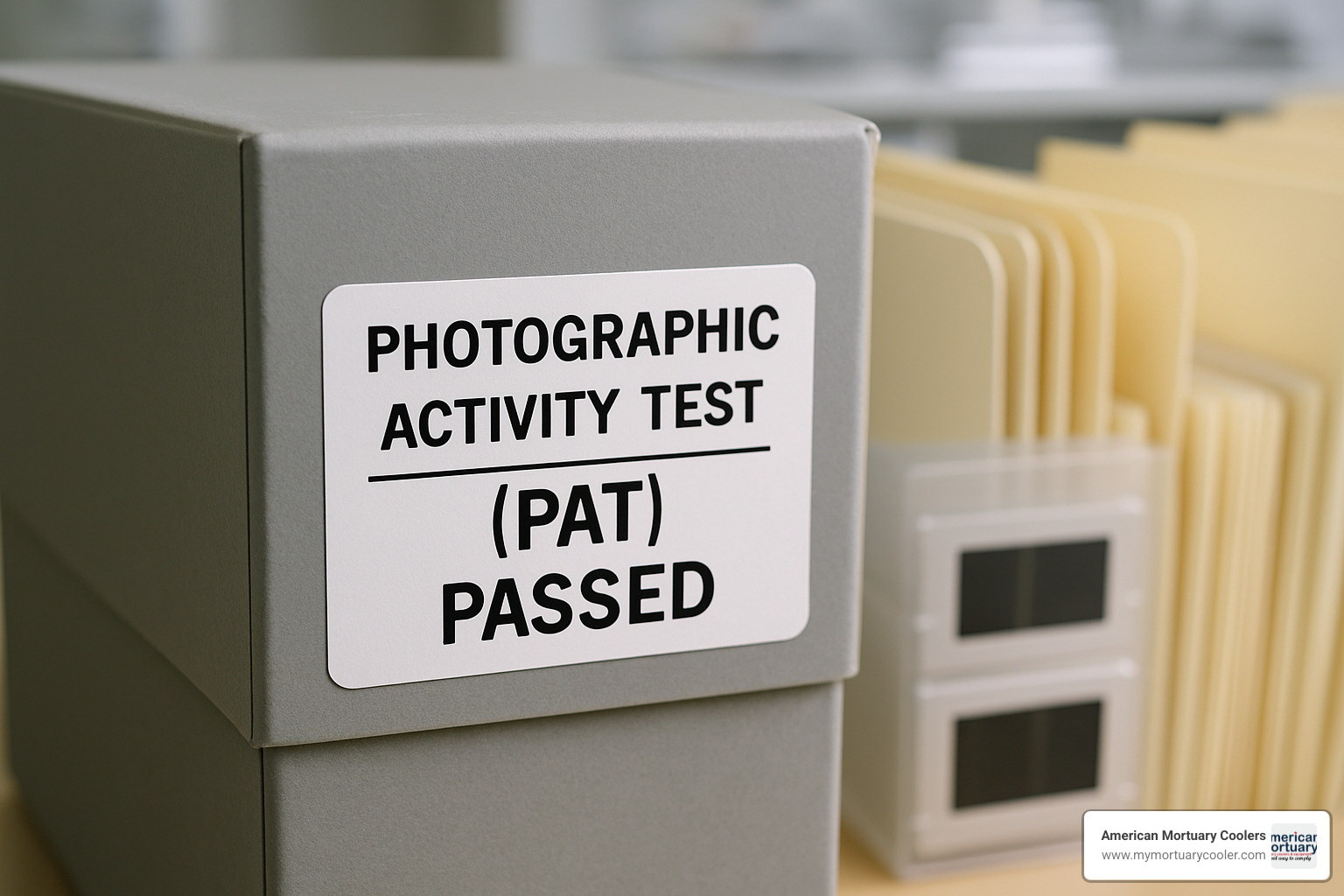
Acid-free construction is essential. Good storage materials maintain a neutral to slightly alkaline pH (7.0-8.5) to prevent acid migration that can damage slides over time. For buffered materials, you might see a slightly higher pH range of 8.0-9.5.
The Photographic Activity Test (PAT) is the gold standard for photographic storage materials. This ISO 14523 test determines whether storage materials will chemically interact with photographic elements. Always look for products that proudly display their PAT certification.
Lignin-free materials matter because lignin naturally breaks down into acids over time. Quality archival boxboard should have a Kappa number of 5 or less, indicating minimal lignin content that could harm your slides.
The buffered versus unbuffered decision is important too. Buffered materials contain calcium carbonate (typically 3% or more) that helps neutralize acids that form over time. While buffered materials work great for most slides, certain photographic processes like cyanotypes may actually be damaged by the alkaline environment, requiring unbuffered materials instead.
High-quality archival materials also limit metal impurities (less than 150 ppm iron and 6 ppm copper) to prevent catalytic degradation and avoid optical brightening agents that can break down and potentially harm photographic materials over time.
At American Mortuary Coolers, we understand these preservation principles well. The same science that guides proper specimen preservation in our cooling systems applies to protecting delicate slides. Whether you're preserving scientific specimens in Johnson City, Tennessee, or microscope slides in a lab in Chicago, the fundamental principles of preservation remain the same.
The right slide storage solution isn't just about organization—it's about protecting irreplaceable memories and valuable specimens for generations to come. As scientific research on archival enclosures continues to advance our understanding of preservation, we're committed to providing solutions that meet these evolving standards.
Choosing the Right Slide Storage Solution
Selecting the appropriate slide storage solution doesn't have to be overwhelming. Whether you're preserving family memories or managing a laboratory collection, finding the right storage option comes down to a few key factors.

Matching Slide Storage to Collection Size and Access Frequency
Think of your slide collection like a library - the size and how often you need to access it should guide your storage decisions.
For those small personal collections under 200 slides, standard 35mm slide boxes work beautifully. These compact solutions safely cradle up to 200 cardboard-mounted slides or about 80 of the more delicate glass-mounted varieties. Many photographers prefer polypropylene pages in a simple binder, which let you view your slides without handling them directly - perfect for those family vacation memories you love to revisit.
Medium-sized collections between 200-1,000 slides call for a bit more structure. Metal-edged archival boxes are workhorses that can accommodate up to 480 35mm slides in individual holders. I particularly like slide tray bins that organize 25 slides per tray with 8 trays per box - they make finding that specific holiday slide from 1978 so much easier!
For serious collectors or laboratories with over 1,000 slides, it's time to consider dedicated furniture. Laboratory-grade slide cabinets can house up to 5,000 microscope slides in organized drawers. These modular systems can grow with your collection, starting modest and expanding as needed.
"For many people, their childhood memories are documented with photographic slides," a preservation specialist once told me. "While the medium may be obsolete, the memories contained within deserve to be shared and preserved for future generations." The same care applies to valuable scientific specimens that might hold irreplaceable research.
Selecting Materials and Formats for Slide Storage
The materials protecting your slides matter tremendously for long-term preservation.
For photographic slides, polypropylene pages with an 8 mil thickness offer excellent transparency while remaining chemically stable. Many archivists prefer archival-quality boxboard with calcium carbonate buffer that actively neutralizes acids that could damage your slides over time. For extra-special individual slides, polyester sleeves (3 mil) provide superior protection.
Microscope slides have different needs. High-impact polystyrene boxes with hinged lids keep dust at bay, while hardwood boxes with carefully grooved slots cradle larger specialty slides. For laboratories with extensive collections, metal cabinets with powder-coated finishes provide both protection and easy access.
Your format options range from simple to sophisticated:
Boxes and cases come in sizes from pocket-sized 100-slide containers to furniture-grade cabinets holding thousands. Binder pages typically accommodate 20 slides per page, with heavyweight options for extra durability. For transporting slides, dedicated slide mailers with recessed compartments protect delicate specimens during shipping. Many researchers prefer storage strips that hold 4-10 slides for quick access to frequently used sets.
Budget & Product Recommendations
Quality slide storage solutions fit every budget, from affordable basics to premium preservation systems.
Budget-conscious collectors can start with Print File 2×2-20B Slide Preservers at around $12.50 for a 25-pack. These pages hold 20 slides each and slip into any standard binder. Polystyrene slide boxes with hinged lids ($18-25) comfortably house 100 slides, while simple cardboard slide folders with numbered compartments ($5-10) organize smaller sets of 20 slides.
For mid-range solutions, the Gaylord Archival Slide Storage Kit ($50-80) includes both an acid-free box and protective pages - a complete solution in one package. Metal-edged archival boxes with dividers ($30-60) offer excellent protection for up to 480 slides, while modular file storage systems ($100-200) can accommodate collections up to 1,200 slides.
Serious collectors and laboratories might consider laboratory-grade slide storage cabinets ($200-3,000) that hold up to 5,000 slides with organized drawer systems. Specialized systems like OmniStor or CellNass SmartStor provide integrated solutions for pathology labs, while custom hardwood storage boxes ($100-300) offer both protection and elegance for specialty slides.
I particularly recommend Print File 2×2-20B Slide Preservers for photographic slides. Their acid-free 8 mil polypropylene construction and handy ID strips for labeling make organization a breeze. For microscope slides in laboratory settings, a quality Slide Storage Cabinet holding 5,000 slides offers the perfect balance of capacity and organization with six labeled drawers and durable metal construction.

At American Mortuary Coolers, we understand preservation principles apply across disciplines. While our expertise centers on mortuary coolers and specimen refrigeration throughout the Southeast, Southwest, and Pacific regions, we recognize that proper storage is essential for preserving valuable items of all kinds.
Best Practices for Handling, Organizing, and Environmental Control
Taking care of your slides isn't just about having the right containers—it's about how you handle them, organize them, and control their environment. With some simple practices, you can dramatically extend the life of your valuable slides while keeping them easy to find when needed.

Handling Guidelines to Prevent Damage
I've seen countless beautiful slides ruined by fingerprints or scratches that could have been easily prevented. The oils from your fingers can permanently damage slide emulsions and attract dust—a heartbreaking way to lose irreplaceable memories or specimens.
Start by working on a clean, clear surface with enough space to move comfortably. For valuable slides, slip on a pair of antistatic gloves—cotton or nitrile work wonderfully to prevent oils and fingerprints from transferring to your slides.
Always hold slides by their mounts or edges, never touching the film surface or specimen area. This is especially important with microscope slides, where even the lightest touch on a coverslip can disturb the specimen beneath.
"I learned this lesson the hard way with my grandfather's slides from World War II," shares a customer from our Chicago location. "One fingerprint on the emulsion, and that memory was permanently smudged. Now I always use gloves."
When examining slides, use proper illumination but be mindful of exposure time. A good light box or illuminated slide sorter lets you view photographic slides safely without excessive light damage. For detailed inspection, an 8× loupe is your friend—it allows examination without removing slides from their protective sleeves.
Remember to let slides acclimate to room temperature before handling if they've been in cold storage. The condensation that forms on cold slides can cause water damage to the emulsion or specimen.
And please, resist the temptation to use compressed air for cleaning—it can force dust particles into the emulsion or specimen. Instead, gently use a soft brush or photographer's blower bulb to remove dust.
Cataloging & Labeling for Easy Retrieval
Nothing's more frustrating than knowing you have a slide but not being able to find it. A thoughtful cataloging system transforms a jumble of slides into an accessible collection.
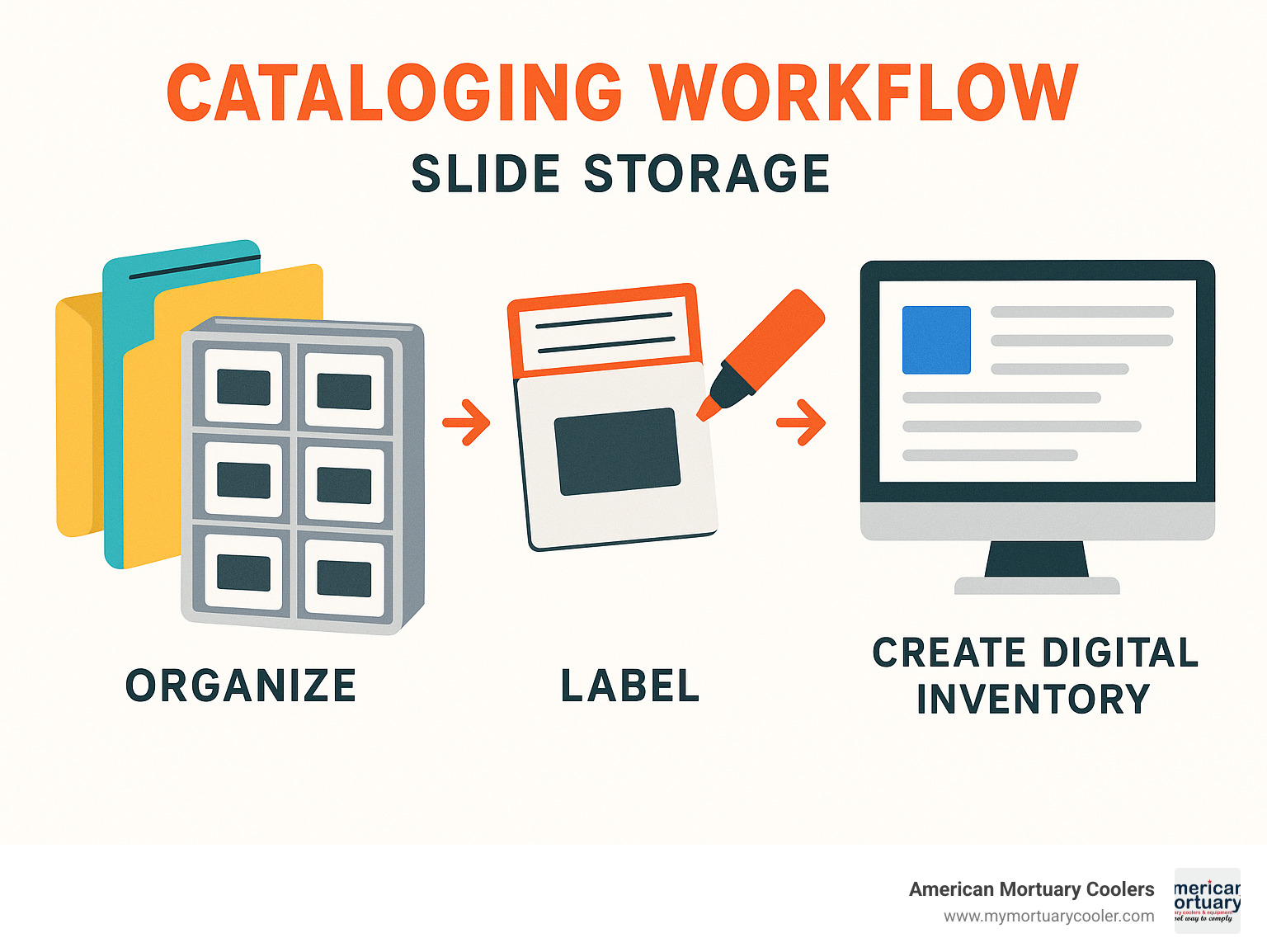
Start with ID strips on slide pages or index cards in storage boxes—these allow you to identify contents without handling individual slides. Implement a numbering system that makes sense for your collection type. Family photographs might work best organized chronologically or by event, while scientific collections often benefit from taxonomic or specimen-based organization.
"The numbered index sheets in our storage system completely transformed our workflow," explains a pathology lab manager from Dallas. "What used to take minutes to locate now takes seconds, and we've eliminated the handling damage we used to see."
For larger collections, especially in laboratory settings, consider barcode labeling to track slides through various processes. This pairs beautifully with a digital catalog using spreadsheet software or specialized collection management tools. In your catalog, record essentials like identification numbers, creation dates, subject information, physical location, condition notes, and usage history.
Label your storage containers clearly with archival-quality markers or labels, but avoid putting adhesive labels directly on slides themselves. Organize by logical groupings that make retrieval intuitive—whether that's by subject, date, location, or specimen type.
Ideal Storage Environment
The environment surrounding your slide storage can be just as important as the storage containers themselves. Think of environmental control as invisible protection that dramatically extends slide life.
For temperature, aim for 60-65°F (15-18°C) for photographic slides, with color slides particularly benefiting from cooler storage. Microscope slides do well at slightly warmer temperatures of 65-70°F (18-21°C), which prevents thermal stress on the glass and specimens.
Humidity is crucial—too high and you risk mold growth, too low and materials become brittle. The sweet spot is between 30-40% relative humidity for most slide types. Small silica gel desiccant packets placed in your storage containers can help maintain stable humidity levels. Just remember to refresh or replace them periodically.
"A stable environment is absolutely critical," notes our preservation specialist. "I've seen simple cardboard boxes preserve slides for decades because they were kept in stable conditions, while expensive cabinets couldn't save slides stored in damp basements or hot attics."
Keep your slides in dark environments when not in use, as light exposure is cumulative and irreversible. If you're displaying or viewing slides regularly, consider UV-filtering materials, and limit projection time for particularly valuable slides.
Air quality matters too—choose storage locations away from pollution sources like cooking fumes, cigarette smoke, or industrial emissions. For valuable collections, an air filtration system might be worth considering.
Perhaps most important is stability—prevent rapid fluctuations in temperature and humidity, which can be more damaging than consistent conditions outside the ideal range. Inexpensive data loggers can help you monitor conditions in your storage area, giving you peace of mind that your memories or specimens are safe.
At American Mortuary Coolers, we apply these same environmental control principles to our specimen refrigeration systems across our service locations. Whether you're preserving family memories or scientific specimens, the fundamentals of good preservation remain the same: gentle handling, thoughtful organization, and a stable environment.
For more information about specialized storage equipment, visit our page about Anatomic Pathology Equipment.
Digitizing, Shipping, and Long-Term Monitoring
As technology advances and collections age, comprehensive slide storage strategies now include digitization, safe transportation protocols, and systematic monitoring procedures to ensure long-term preservation.
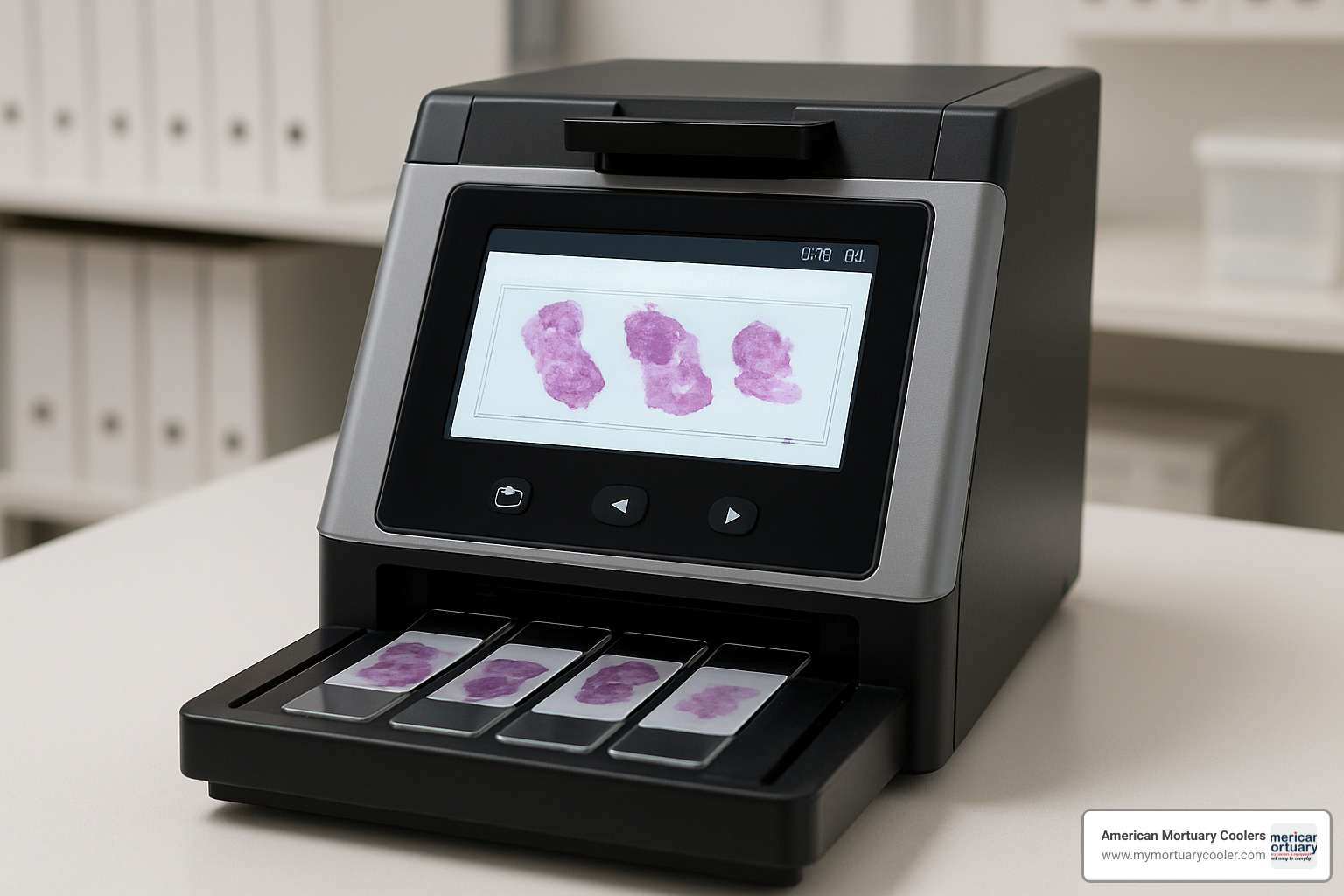
Digitizing as a Preservation Strategy
Creating digital backups of your slides isn't just about convenience—it's about preserving memories and specimens that might otherwise be lost to time. Digital copies provide insurance against physical damage, make sharing with family or colleagues effortless, and reduce the need to handle delicate originals.
The good news is you have several options for bringing your slides into the digital world. Many folks start with flatbed scanners with transparency adapters, which are budget-friendly for smaller collections though they can be a bit tedious for large batches.
If you're serious about digitizing a substantial collection, dedicated slide scanners might be worth the investment. These purpose-built devices often feature automated feeding systems that make quick work of multiple slides. Prices typically range from about $200 for home use models to over $2,000 for professional equipment that captures the finest details.
Photography enthusiasts might prefer creating DSLR camera rigs with macro lenses and proper lighting. This approach gives you tremendous control over image quality and works beautifully for both photographic and microscope slides.
"I set up a simple DSLR rig in my garage and digitized my father's entire collection of vacation slides from the 1960s," shares a customer from our Nashville region. "Now the whole family can enjoy these memories without risking damage to the originals."
For those who'd rather not tackle the project themselves, professional digitization services offer high-volume, high-quality scanning. Expect to pay between $0.30 and $1.00 per slide depending on resolution and service level—a worthwhile investment for irreplaceable collections.
Even smartphone apps can capture decent images of slides when placed on a light source. While not archival quality, they're perfect for quick reference or sharing on social media.
Digitization complements rather than replaces proper physical slide storage. Digital files have their own preservation challenges and require active management as technology evolves. Always maintain multiple backups using the 3-2-1 rule: three copies, two different media types, one off-site location.
Preparing Slides for Safe Shipping or Off-Site Storage
Whether you're sending slides for digitization, sharing with colleagues, or relocating to off-site storage, proper preparation prevents heartbreaking damage in transit.
For photographic slides, consider keeping things simple by stacking slides into manageable 2-4 inch piles and securing them with rubber bands. Make sure all slides face the same direction and clearly label the first slide in each stack. Many digitization services actually prefer receiving entire carousel trays rather than loose slides—this maintains the original sequence and provides built-in protection.
"Shipping the whole carousel minimizes prep time but increases shipping costs," notes a digitization expert from our Los Angeles office. "You decide based on the value of your time versus your budget."
Microscope slides require extra care due to their fragility. Specialized slide mailers with recessed compartments prevent slides from touching covers and breaking during transit. For valuable specimens, consider double-boxing with ample cushioning material and including desiccant packets to control humidity during shipping.
For all slide types, rigid containers are non-negotiable—they prevent bending or flexing that can permanently damage your slides. Add sufficient cushioning to prevent movement, and avoid exposing your package to extreme temperatures during shipping. For truly valuable collections, climate-controlled shipping options are worth the extra cost.
Don't forget to insure your shipment appropriately! The replacement value of rare specimens or family memories often far exceeds the standard insurance included with most shipping services.
Ongoing Maintenance & Monitoring
Even the best slide storage solution requires ongoing attention—think of it as regular health check-ups for your collection.
Develop a regular inspection schedule where you examine representative samples quarterly for early signs of deterioration. A complete collection assessment once a year helps you spot broader patterns or issues. Document any condition changes with photographs and written records so you can track progression over time.
"I set calendar reminders for my quarterly slide checks," shares a pathology lab manager from our Pittsburgh region. "It only takes about 15 minutes, but it's saved us from losing valuable specimens several times when we caught early signs of problems."
Environmental monitoring doesn't need to be complicated. Simple data loggers can track temperature and humidity fluctuations, giving you concrete information about your storage conditions. Review these logs monthly and make adjustments as needed—sometimes something as simple as moving your slide storage cabinet away from an exterior wall can make a significant difference.
Don't forget to maintain the storage materials themselves. Replace deteriorating boxes or pages promptly, clean storage cabinets with appropriate non-chemical methods, and refresh desiccants according to manufacturer recommendations. Those little silica gel packets aren't eternal—they need regular replacement to remain effective.
At American Mortuary Coolers, we understand the importance of monitoring and maintenance for preservation equipment. Our experience with specimen refrigeration across the country has taught us that regular monitoring prevents preservation disasters. Whether it's a sophisticated mortuary cooling system or a simple slide storage cabinet, the principle remains the same: prevention through vigilance is always easier than recovery after damage.
"The biggest preservation failures we see come not from choosing the wrong initial storage, but from neglecting ongoing monitoring and maintenance," observes our specialist. "A simple quarterly check can identify developing problems before they cause irreversible damage."
Frequently Asked Questions about Slide Storage
What temperature and humidity should I aim for?
Finding the sweet spot for slide storage conditions can feel like a balancing act, but getting it right makes all the difference for your precious slides.
For photographic slides, aim to keep temperatures between 60-65°F (15-18°C), while microscope slides do best at a slightly warmer 65-70°F (18-21°C). As for humidity, the golden range is 30-40% for most slide types.
What matters most isn't just hitting these numbers but keeping them stable. Think of your slides as creatures of habit—they don't appreciate surprises! Try to avoid temperature swings greater than 5°F or humidity changes exceeding 5% within a 24-hour period.
"I've seen collections stored in simple boxes last beautifully for decades because they were kept in stable conditions," shares one of our preservation specialists from our Tennessee facility.
If you're serious about preservation, cold storage (below 40°F) can dramatically extend the life of color slides. Just remember, when bringing slides out from the cold, patience is key—let them warm up in their sealed containers for a full day before opening to prevent condensation from forming on your treasured memories.
Buffered or unbuffered enclosures—how do I choose?
The buffered versus unbuffered decision often confuses even experienced collectors. Let me break it down in simple terms.
Buffered materials contain calcium carbonate, which acts like a built-in antacid, neutralizing acids that naturally form as paper and cardboard age. These work wonderfully for most black and white slides, Kodachrome slides, glass-mounted slides with paper mounts, and microscope slides with paper labels.
Unbuffered materials lack this alkaline buffer and are the safer choice for cyanotypes, dye transfer prints, certain color processes, and protein-based emulsions like albumen. These materials can actually react negatively with alkaline buffers.
Not sure what type of slides you have? When in doubt, unbuffered materials are the safer bet, though they provide less long-term acid protection. For mixed collections, I often recommend a compromise—use unbuffered materials for anything directly touching your slides, with buffered materials for outer boxes and containers.
How many slides can standard boxes and cabinets hold?
Planning your slide storage needs starts with understanding capacity limits. Nothing's worse than investing in a storage system only to find it's too small!
For those family memories on 35mm photographic slides, a standard archival box typically holds about 200 cardboard-mounted slides or 80 of the thicker glass-mounted variety. If you're using polypropylene pages in binders (my personal favorite for easy viewing), expect to fit 20 slides per page.
Laboratory professionals working with microscope slides have different needs. A standard plastic slide box neatly organizes 100 slides in individually numbered slots, while serious collectors might invest in a laboratory cabinet that houses an impressive 5,000 slides across six drawers.
Here's a tip from years of helping clients across our service regions: always plan for growth by adding 10-15% extra capacity to your initial estimates. This prevents overcrowding and reduces the risk of damage when retrieving slides.
"I learned this lesson the hard way," laughs one of our customers from Chicago. "I bought exactly what I needed for my current collection, only to inherit my uncle's slides a month later!"
How do I clean dusty or dirty slides before storage?
Before tucking your slides into their new slide storage home, a gentle cleaning might be in order—emphasis on gentle!
For photographic slides, start with the lightest touch possible. A soft brush or photographic blower bulb easily removes loose dust without risking scratches. For stubborn spots, a microfiber cloth designed for camera lenses can work wonders. Whatever you do, keep water, alcohol, and commercial cleaners far away from film emulsions—they'll do more harm than good.
Microscope slides require an equally delicate approach. Lens tissue works beautifully for dust removal, and for fingerprints on non-specimen areas, a tiny amount of isopropyl alcohol applied to the tissue (never directly to the slide) usually does the trick.
Cleaning always carries some risk of damage, so once your slides are clean, immediate placement in proper slide storage prevents the need for future cleaning sessions. As we like to say at American Mortuary Coolers, "An ounce of prevention saves a pound of irreplaceable memories."
Can I store different types of slides together?
While it might seem convenient to keep all your slides in one place, mixing different types in the same slide storage container isn't always the wisest choice.
Glass-mounted and cardboard-mounted slides make uncomfortable neighbors—their different thicknesses and fragility levels mean they're better off in separate accommodations. Similarly, acetate and polyester-based films age differently and prefer their own space.
Pay special attention to any slides showing warning signs like vinegar odor or discoloration. Like a patient with a cold, these slides need quarantine to prevent their deterioration from spreading to healthy materials.
If separate storage isn't practical for your situation, consider using individual polypropylene sleeves or paper envelopes as a buffer before placing different slide types together. It's like giving each slide its own private room within a shared house.
At American Mortuary Coolers, we understand the importance of proper storage and preservation—whether it's the sensitive equipment we provide to funeral homes across the country or the precious family memories captured on your slides. The principles of careful preservation remain the same: the right environment, proper handling, and appropriate materials make all the difference.
Conclusion
Proper slide storage is like creating a time capsule for your precious memories and specimens. Whether you're safeguarding family photographs that tell your story or protecting scientific slides that represent years of research, the fundamentals remain the same: shield from light, keep dust at bay, control humidity, and prevent physical damage—all while maintaining a system that lets you find what you need when you need it.

I've seen how following the guidelines we've discussed can transform the lifespan of slide collections. When you accept archival-quality materials that pass the PAT test, you're giving your slides their best chance at longevity. When you handle slides with gloves and proper technique, you're preventing oils and fingerprints that can cause permanent damage. Creating an organizational system isn't just about neatness—it's about minimizing handling and knowing exactly where each slide lives.
The environment surrounding your slide storage matters tremendously. A stable temperature and humidity level might seem like small details, but they're the difference between slides that last for generations and those that deteriorate in just a few years. Regular check-ups on your collection might feel unnecessary, but catching issues early can save irreplaceable items.
Many collectors and professionals are now adding digitization to their preservation strategy. It's not a replacement for proper physical storage, but rather a wonderful complement that creates another layer of protection while making sharing and viewing easier.
Here at American Mortuary Coolers, we understand preservation on a deep level. While our primary business focuses on custom mortuary coolers and specimen refrigeration solutions delivered across the contiguous 48 states, the science of preservation connects all our work—whether it's protecting tissue specimens in our refrigeration systems or helping you safeguard valuable slides in archival storage.
From our Tennessee home base to our service areas spanning the Midwest, Southeast, Southwest, and Pacific regions, we love sharing knowledge that helps professionals and families maintain what matters most to them.
I often tell clients that you don't need to break the bank to properly preserve your slides. As one archivist friend puts it, "Even the most expensive cabinet won't save your slides if you're handling them with bare hands near an open window, but even simple cardboard boxes can preserve slides for decades when used correctly in the right environment."
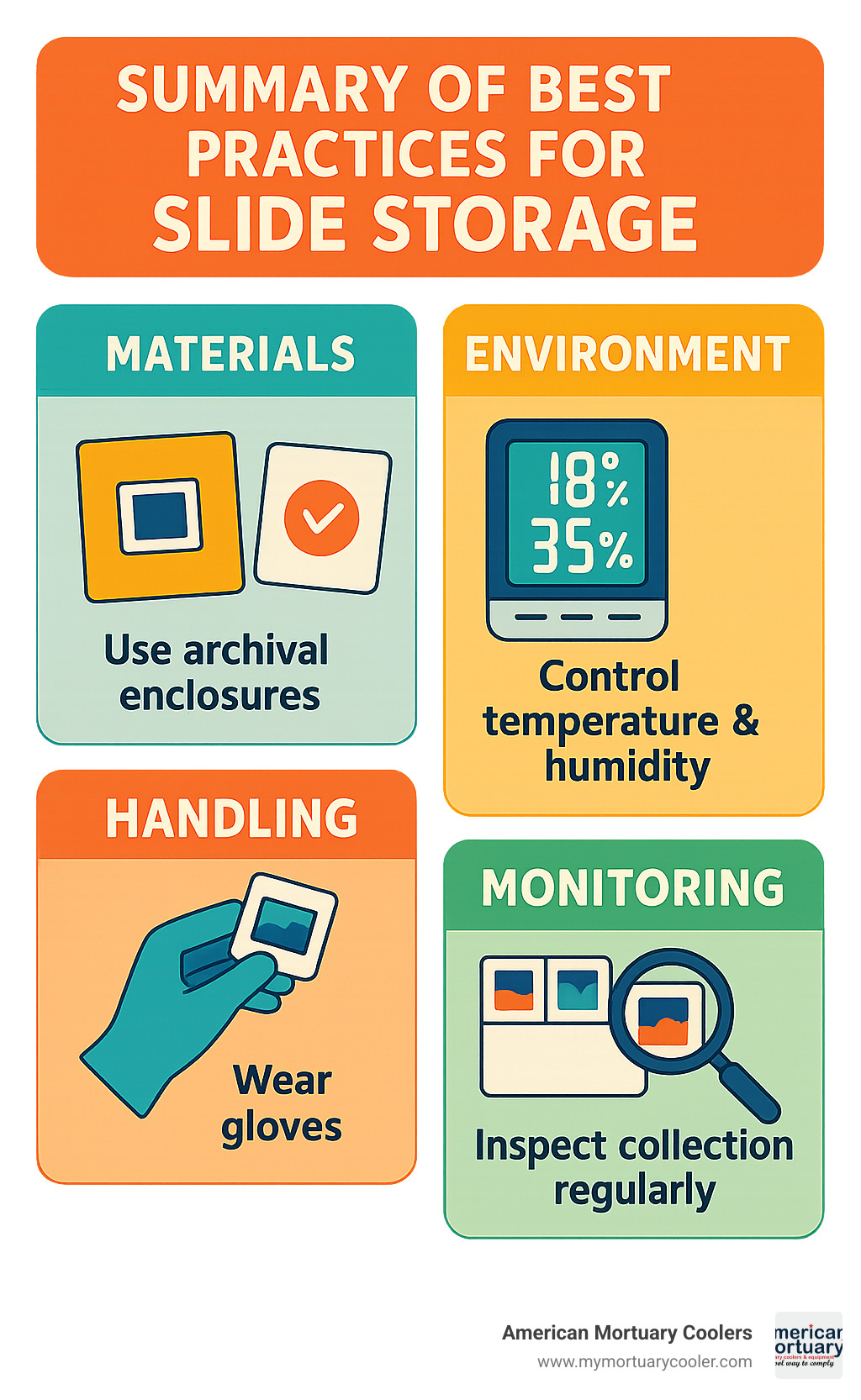
Your investment in proper slide storage today ensures that what matters to you—whether cherished family memories or groundbreaking scientific specimens—remains intact and accessible for the next generation. After all, the stories and knowledge contained in these small transparent windows deserve our very best care.


















